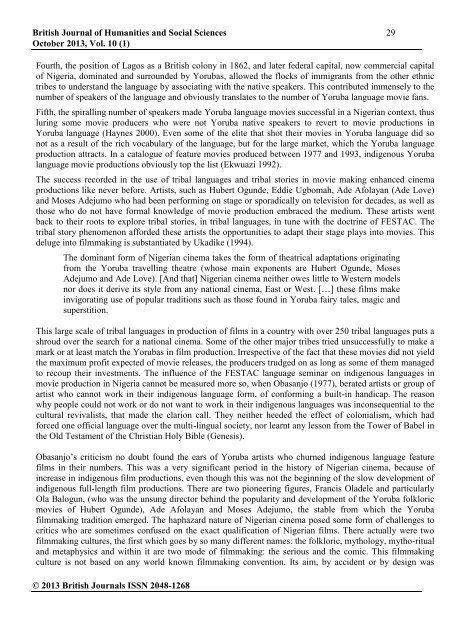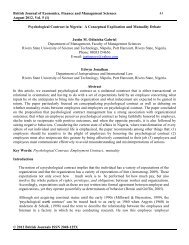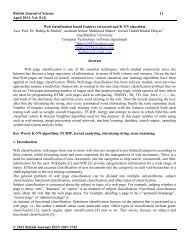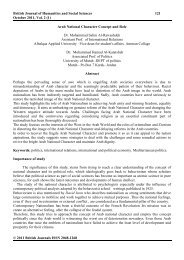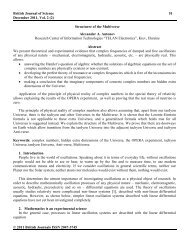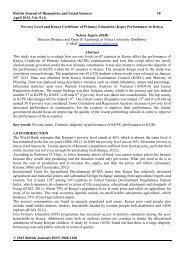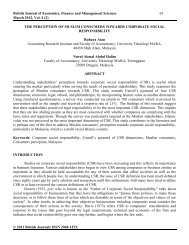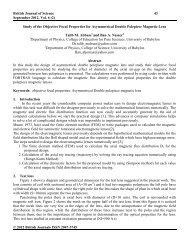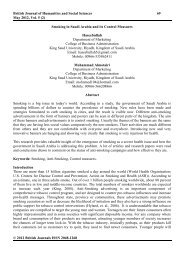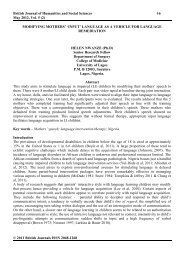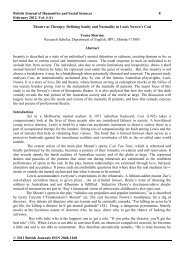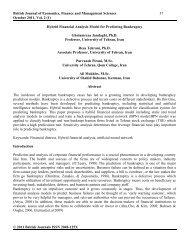British Journal <strong>of</strong> Humanities <strong>and</strong> Social Sciences 29October 2013, Vol. 10 (1)Fourth, <strong>the</strong> position <strong>of</strong> Lagos as a British colony <strong>in</strong> 1862, <strong>and</strong> later federal capital, now commercial capital<strong>of</strong> Nigeria, dom<strong>in</strong>ated <strong>and</strong> surrounded by Yorubas, allowed <strong>the</strong> flocks <strong>of</strong> immigrants from <strong>the</strong> o<strong>the</strong>r ethnictribes to underst<strong>and</strong> <strong>the</strong> language by associat<strong>in</strong>g with <strong>the</strong> native speakers. This contributed immensely to <strong>the</strong>number <strong>of</strong> speakers <strong>of</strong> <strong>the</strong> language <strong>and</strong> obviously translates to <strong>the</strong> number <strong>of</strong> Yoruba language movie fans.Fifth, <strong>the</strong> spirall<strong>in</strong>g number <strong>of</strong> speakers made Yoruba language movies successful <strong>in</strong> a Nigerian context, thuslur<strong>in</strong>g some movie producers who were not Yoruba native speakers to revert to movie productions <strong>in</strong>Yoruba language (Haynes 2000). Even some <strong>of</strong> <strong>the</strong> elite that shot <strong>the</strong>ir movies <strong>in</strong> Yoruba language did sonot as a result <strong>of</strong> <strong>the</strong> rich vocabulary <strong>of</strong> <strong>the</strong> language, but for <strong>the</strong> large market, which <strong>the</strong> Yoruba languageproduction attracts. In a catalogue <strong>of</strong> feature movies produced between 1977 <strong>and</strong> 1993, <strong>in</strong>digenous Yorubalanguage movie productions obviously top <strong>the</strong> list (Ekwuazi 1992).The success recorded <strong>in</strong> <strong>the</strong> use <strong>of</strong> tribal languages <strong>and</strong> tribal stories <strong>in</strong> movie mak<strong>in</strong>g enhanced c<strong>in</strong>emaproductions like never before. Artists, such as Hubert Ogunde, Eddie Ugbomah, Ade Afolayan (Ade Love)<strong>and</strong> Moses Adejumo who had been perform<strong>in</strong>g on stage or sporadically on television for decades, as well asthose who do not have formal knowledge <strong>of</strong> movie production embraced <strong>the</strong> medium. These artists wentback to <strong>the</strong>ir roots to explore tribal stories, <strong>in</strong> tribal languages, <strong>in</strong> tune with <strong>the</strong> doctr<strong>in</strong>e <strong>of</strong> FESTAC. Thetribal story phenomenon afforded <strong>the</strong>se artists <strong>the</strong> opportunities to adapt <strong>the</strong>ir stage plays <strong>in</strong>to movies. Thisdeluge <strong>in</strong>to filmmak<strong>in</strong>g is substantiated by Ukadike (1994).The dom<strong>in</strong>ant form <strong>of</strong> Nigerian c<strong>in</strong>ema takes <strong>the</strong> form <strong>of</strong> <strong>the</strong>atrical adaptations orig<strong>in</strong>at<strong>in</strong>gfrom <strong>the</strong> Yoruba travell<strong>in</strong>g <strong>the</strong>atre (whose ma<strong>in</strong> exponents are Hubert Ogunde, MosesAdejumo <strong>and</strong> Ade Love). [And that] Nigerian c<strong>in</strong>ema nei<strong>the</strong>r owes little to Western modelsnor does it derive its style from any national c<strong>in</strong>ema, East or West. […] <strong>the</strong>se films make<strong>in</strong>vigorat<strong>in</strong>g use <strong>of</strong> popular traditions such as those found <strong>in</strong> Yoruba fairy tales, magic <strong>and</strong>superstition.This large scale <strong>of</strong> tribal languages <strong>in</strong> production <strong>of</strong> films <strong>in</strong> a country with over 250 tribal languages puts ashroud over <strong>the</strong> search for a national c<strong>in</strong>ema. Some <strong>of</strong> <strong>the</strong> o<strong>the</strong>r major tribes tried unsuccessfully to make amark or at least match <strong>the</strong> Yorubas <strong>in</strong> film production. Irrespective <strong>of</strong> <strong>the</strong> fact that <strong>the</strong>se movies did not yield<strong>the</strong> maximum pr<strong>of</strong>it expected <strong>of</strong> movie releases, <strong>the</strong> producers trudged on as long as some <strong>of</strong> <strong>the</strong>m managedto recoup <strong>the</strong>ir <strong>in</strong>vestments. The <strong>in</strong>fluence <strong>of</strong> <strong>the</strong> FESTAC language sem<strong>in</strong>ar on <strong>in</strong>digenous languages <strong>in</strong>movie production <strong>in</strong> Nigeria cannot be measured more so, when Obasanjo (1977), berated artists or group <strong>of</strong>artist who cannot work <strong>in</strong> <strong>the</strong>ir <strong>in</strong>digenous language form, <strong>of</strong> conform<strong>in</strong>g a built-<strong>in</strong> h<strong>and</strong>icap. The reasonwhy people could not work or do not want to work <strong>in</strong> <strong>the</strong>ir <strong>in</strong>digenous languages was <strong>in</strong>consequential to <strong>the</strong>cultural revivalists, that made <strong>the</strong> clarion call. They nei<strong>the</strong>r heeded <strong>the</strong> effect <strong>of</strong> colonialism, which hadforced one <strong>of</strong>ficial language over <strong>the</strong> multi-l<strong>in</strong>gual society, nor learnt any lesson from <strong>the</strong> Tower <strong>of</strong> Babel <strong>in</strong><strong>the</strong> Old Testament <strong>of</strong> <strong>the</strong> Christian Holy Bible (Genesis).Obasanjo‘s criticism no doubt found <strong>the</strong> ears <strong>of</strong> Yoruba artists who churned <strong>in</strong>digenous language featurefilms <strong>in</strong> <strong>the</strong>ir numbers. This was a very significant period <strong>in</strong> <strong>the</strong> history <strong>of</strong> Nigerian c<strong>in</strong>ema, because <strong>of</strong><strong>in</strong>crease <strong>in</strong> <strong>in</strong>digenous film productions, even though this was not <strong>the</strong> beg<strong>in</strong>n<strong>in</strong>g <strong>of</strong> <strong>the</strong> slow development <strong>of</strong><strong>in</strong>digenous full-length film productions. There are two pioneer<strong>in</strong>g figures, Francis Oladele <strong>and</strong> particularlyOla Balogun, (who was <strong>the</strong> unsung director beh<strong>in</strong>d <strong>the</strong> popularity <strong>and</strong> development <strong>of</strong> <strong>the</strong> Yoruba folkloricmovies <strong>of</strong> Hubert Ogunde), Ade Afolayan <strong>and</strong> Moses Adejumo, <strong>the</strong> stable from which <strong>the</strong> Yorubafilmmak<strong>in</strong>g tradition emerged. The haphazard nature <strong>of</strong> Nigerian c<strong>in</strong>ema posed some form <strong>of</strong> challenges tocritics who are sometimes confused on <strong>the</strong> exact qualification <strong>of</strong> Nigerian films. There actually were tw<strong>of</strong>ilmmak<strong>in</strong>g cultures, <strong>the</strong> first which goes by so many different names: <strong>the</strong> folkloric, mythology, mytho-ritual<strong>and</strong> metaphysics <strong>and</strong> with<strong>in</strong> it are two mode <strong>of</strong> filmmak<strong>in</strong>g: <strong>the</strong> serious <strong>and</strong> <strong>the</strong> comic. This filmmak<strong>in</strong>gculture is not based on any world known filmmak<strong>in</strong>g convention. Its aim, by accident or by design was© 2013 British Journals ISSN 2048-1268
British Journal <strong>of</strong> Humanities <strong>and</strong> Social Sciences 30October 2013, Vol. 10 (1)geared towards cultural revival accord<strong>in</strong>g to Ekwuazi (1992). Referenc<strong>in</strong>g Ferid Boughedir he writes that <strong>the</strong>films did not just idealized folklores, but as a bold statement aga<strong>in</strong>st Western cultures <strong>and</strong> with greatau<strong>the</strong>nticity, it resorts to restor<strong>in</strong>g <strong>the</strong> ways <strong>of</strong> life <strong>of</strong> <strong>the</strong> African popular masses. The narrative is basedlargely on myth, legend <strong>and</strong> superstitious cultural beliefs. The narratives, tied to <strong>the</strong> Yoruba travell<strong>in</strong>g<strong>the</strong>atre is favoured <strong>and</strong> popularised by this large Nigerian tribe. The second filmmak<strong>in</strong>g culture isperpetuated particularly by film scholars tra<strong>in</strong>ed <strong>in</strong> Western film schools. They have <strong>the</strong>ir narrativesexecuted along <strong>the</strong> l<strong>in</strong>e <strong>of</strong> ma<strong>in</strong>stream movies deal<strong>in</strong>g with social <strong>and</strong> current realities. Depend<strong>in</strong>g on <strong>the</strong>stories <strong>and</strong> <strong>the</strong> commercial attraction, <strong>the</strong> production language <strong>of</strong> this second filmmak<strong>in</strong>g culture oscillatesbetween English <strong>and</strong> Yoruba.Themes, Genre <strong>and</strong> <strong>the</strong> Pa<strong>in</strong>s <strong>in</strong> <strong>Language</strong> MoviesWhat eventually evolved from <strong>the</strong> Yoruba Travell<strong>in</strong>g <strong>the</strong>atre were two genres <strong>of</strong> movie productions — thosethat deal with serious issues, <strong>and</strong> those that parody those serious issues. In all, two elemental worlds areprojected — <strong>the</strong> world <strong>of</strong> reality <strong>and</strong> <strong>the</strong> world <strong>of</strong> fantasy. In <strong>the</strong> movies, Man is pitched aga<strong>in</strong>st numerousforces which belittle him. Some <strong>of</strong> <strong>the</strong> forces are caused by his unavoidable mistakes, by fellow men or bynature. In <strong>the</strong> process <strong>of</strong> struggl<strong>in</strong>g to overcome <strong>the</strong>se belittl<strong>in</strong>g forces, <strong>the</strong>re is a long ―cha<strong>in</strong> <strong>of</strong> animatednature‖, (Ekwuazi 1992), <strong>in</strong> monstrous human forms, scary animal forms, or plants. This cha<strong>in</strong> <strong>of</strong> fantasiesl<strong>in</strong>ks his real world to his cosmos world, or <strong>the</strong> worlds <strong>of</strong> <strong>the</strong> underworld. It is a world believed to be <strong>in</strong>existence by particularly Africans. Those who harbour this belief are <strong>of</strong> <strong>the</strong> op<strong>in</strong>ion that noth<strong>in</strong>g happens bychance, even natural occurrences. A man‘s failure is attributed to ei<strong>the</strong>r evil mach<strong>in</strong>ation from his enemies,or a curse from <strong>the</strong> gods, or dead ancestors‘ displeasures. Ancestral existence play prom<strong>in</strong>ent role <strong>in</strong> Yorubacosmology, as a result, <strong>the</strong> treatment <strong>of</strong> this subject permeates <strong>the</strong> Yoruba arts. From Duro Ladipo‘s ObaKoso, Amos Tutuola‘s The Palmw<strong>in</strong>e Dr<strong>in</strong>kard, Wale Ogunyemi‘s Langbodo to Wole Soy<strong>in</strong>ka‘s Death <strong>and</strong><strong>the</strong> K<strong>in</strong>g’s Horseman, <strong>and</strong> an <strong>in</strong> depth appreciation <strong>of</strong> Kongi’s Harvest, <strong>the</strong> imagery <strong>of</strong> death, <strong>and</strong> reverencefor ancestors, <strong>and</strong> <strong>the</strong> projection <strong>of</strong> <strong>the</strong> extra-terrestrial world dom<strong>in</strong>ate <strong>the</strong> composition <strong>of</strong> <strong>the</strong> plays. ObaDanlola‘s poetic l<strong>in</strong>es <strong>in</strong> Kongi’s Harvest, which broke <strong>in</strong>to sorrowful ―last dance‖ when <strong>the</strong> prison waderstopped <strong>the</strong> royal drums from play<strong>in</strong>g, is a testimonial to how <strong>the</strong> imagery <strong>of</strong> death shows up, no matter howbrief <strong>in</strong> narrative composition <strong>of</strong> <strong>the</strong> Yoruba dramatists. The facial gestures <strong>and</strong> <strong>the</strong> dance steps taken byOba Danlola <strong>and</strong> his chief were not <strong>of</strong> this earth. There is a k<strong>in</strong>d <strong>of</strong> imag<strong>in</strong>ary transition to <strong>the</strong> world beyond.In <strong>the</strong> movies produced by <strong>the</strong> Yoruba travell<strong>in</strong>g <strong>the</strong>atre practitioners, <strong>the</strong>se issues very <strong>of</strong>ten are takenbeyond <strong>the</strong> terrestrial world to <strong>the</strong> worlds where <strong>the</strong>se powers emanates. The presentation <strong>of</strong> <strong>the</strong>se <strong>in</strong>Nigerian movies are slightly different from those <strong>in</strong> Greek mythology as exemplified <strong>in</strong> Clash <strong>of</strong> <strong>the</strong> Titans(1980), <strong>in</strong> which <strong>the</strong> success <strong>and</strong> failure <strong>of</strong> every human activity <strong>in</strong> <strong>the</strong> terrestrial world, is subject to <strong>the</strong>control <strong>of</strong> <strong>the</strong> gods. Due to <strong>the</strong> fact that <strong>the</strong> Yoruba travell<strong>in</strong>g <strong>the</strong>atre movies are built along this l<strong>in</strong>e <strong>of</strong>narrative, with a long historical tradition <strong>and</strong> ownership <strong>of</strong> stories <strong>and</strong> perform<strong>in</strong>g troupes, <strong>the</strong> problems <strong>of</strong>authorship <strong>of</strong> movies tends to show up. Some critics neglect <strong>the</strong> conventional method where <strong>the</strong> ma<strong>in</strong>director is associated with <strong>the</strong> authorship <strong>of</strong> <strong>the</strong> movie <strong>in</strong> l<strong>in</strong>e with (Stoddart 1995) analysis <strong>of</strong> Alex<strong>and</strong>reAstruc‘s <strong>in</strong>itial argument. The director is seen as an equivalent <strong>of</strong> a literary artist <strong>and</strong> <strong>in</strong> like manner, <strong>the</strong>movie affords him <strong>the</strong> ‗means <strong>of</strong> personal expression‘ <strong>and</strong> as such should be credited with <strong>the</strong> authorship <strong>of</strong>such works he presided over. Swayed by <strong>the</strong> posters that parades <strong>the</strong> names, or companies <strong>of</strong> <strong>the</strong> <strong>the</strong>atrepractitioner‘s, many critics disregarded this <strong>the</strong>ory reiterated by Françoise Truffaut, which emphaticallystates that <strong>the</strong> real artists, or ‗auteurs‘, <strong>of</strong> <strong>the</strong> c<strong>in</strong>ema, were its directors, not its ‗scenarists‘ (screen playwriters). Very much unlike Hollywood where <strong>the</strong> big studios bears <strong>the</strong> responsibility <strong>of</strong> filmmak<strong>in</strong>g, <strong>the</strong>structure <strong>of</strong> Nigerian c<strong>in</strong>ema is different, <strong>and</strong> poses a complex situation <strong>of</strong> authorship particularly whenreferr<strong>in</strong>g to <strong>the</strong> movies <strong>in</strong> which <strong>the</strong> filmmaker is <strong>the</strong> soul <strong>of</strong> <strong>the</strong> production that can hire <strong>and</strong> disb<strong>and</strong>. Theyare <strong>the</strong> chief executive <strong>of</strong>ficer (CEO). The onus <strong>of</strong> f<strong>in</strong>anc<strong>in</strong>g <strong>the</strong> project lies on <strong>the</strong>m. They write <strong>the</strong> filmscript irrespective <strong>of</strong> how imperfect it may be. They hire every o<strong>the</strong>r filmmak<strong>in</strong>g personnel <strong>in</strong>clud<strong>in</strong>g <strong>the</strong>© 2013 British Journals ISSN 2048-1268


